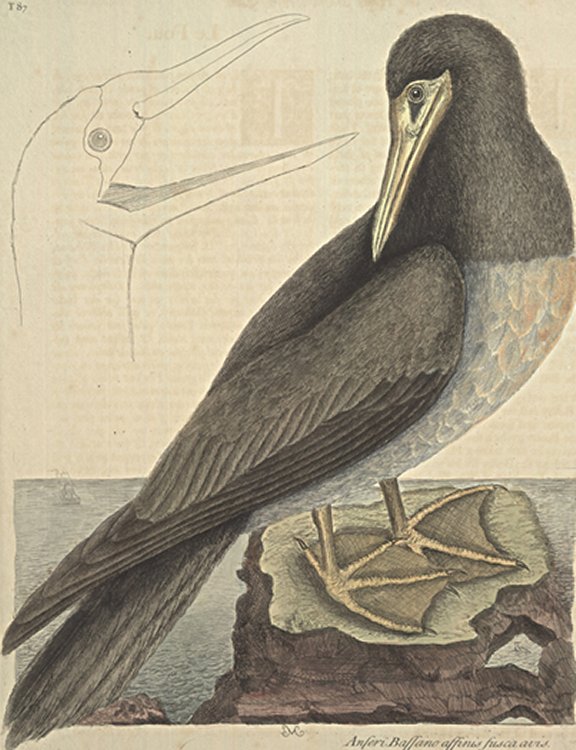Plate Number: I 87Anseri Bassano Fusca Avis: The Booby The Bill is yellow, and bare of feathers; in which the Eyes are placed of a light gray colour; the lower part of the Bill is of a light brown. These Birds vary so, that they are not to be distinguished by their colours only: in one of them the Belly was white, and the Back brown; in another the Breast and Belly was brown; in others all brown; nor could I perceive any outward difference in the Cock and Hen. Their Wings are very long; their Legs and Feet pale yellow, and shap'd like those of Cormorants. They frequent the Bahama Islands, where they breed all months in the year. They lay one, two, and sometimes three eggs on the bare rocks. Dampier says, they breed on Trees in an Island called Bon-airy, in the West-Indies, which he observes not to have seen elsewhere. While young, they are covered with a white Down, and remain so till they are almost ready to fly. They subsist on Fish only, which they catch by diving. This and the great Booby are remarkable for having a joint in the upper mandible of the Bill. It is diverting to see the frequent contests between the Booby and the Man of War Bird, which last lives on rapine and spoil of other Sea Birds, particularly the Booby; which so soon as the Man of War Bird perceives he hath taken a Fish, flies furiously at him, and obliges the Booby for his security to dive under water. The Man of War Bird being incapable of following him, hovers over the place till the Booby rises to breathe, and then attacks him again, and so repeats it at every opportunity, 'till the Booby at length, tired and breathless, is necessitated to resign his fish: yet not being discouraged, industriously goes to fishing again, and suffers repeated losses by fresh assaults from his rapacious Enemy. Having had no opportunity of seeing the Man of War Bird any otherwise than in the Air, I cannot well describe it, nor say any thing more of it, except what has been related to me, which is this: While they are sitting and hatching their young, their Heads change from a brown to a Scarlet colour, which becomes brown again when they have done breeding: This was affirmed to me by many who have often seen them on their Nests; for at that time they are very tame, and will suffer one to come near to them, tho' at other times very wild. These Birds are numerous on most of the Bahama Islands. |